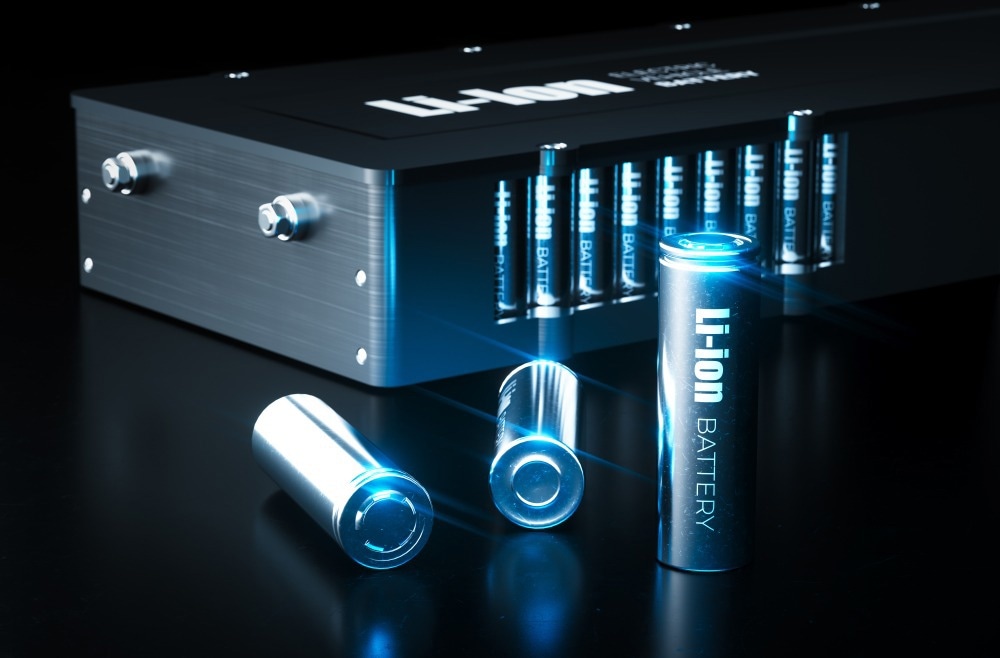Lithium-ion batteries with high energy are being thoroughly researched for use in future electric vehicles (EVs) and scalable energy storage platforms. Due to its high capacity in storing lithium (Li), silicon (Si) has been regarded as a possible anode option. Still, its rate and cycle performance must be improved to see further use.

Study: Enhancing Role of Structurally Integrated V2C MXene Nanosheets on Silicon Anode for Lithium Storage. Image Credit: petrmalinak/Shutterstock.com
A structural integration approach was reported in a study printed in the Journal of Alloys and Compounds for overcoming the main problems of inadequate capacity retention and sluggish kinetics during lithium (Li) storage in silicon anodes.
Areas of Improvement in Lithium-ion Batteries
Lithium-ion batteries have been extensively used as effective electrolytic systems for storing and converting energy in compact electrical devices and EVs. Nonetheless, enhancements to power and energy density, operational life, and quick charge capability are still needed.
As current graphitic anode materials have a limited Li storing capacity, producing silicon-based anodes with significantly higher Li storage capacities, as well as good reliability and cheap costs, is very important for cutting-edge high energy lithium-ion batteries.
Issues with Using Silicon Anodes in Lithium-Ion Batteries
When using the silicon anodes for Li storage, naturally low electric conductivities, significant volume changes, slow kinetics, and unsatisfactory cyclic stability must be overcome.
Many approaches have been studied to increase silicon-based anodes' electrolytic capabilities, like the synthesis of Si/C composites, surface treatment, and nano-engineering of silicon particles.
MXenes, carbon nanotubes (CNTs), carbon nanofibers, and graphene-based materials have been used to incorporate silicon particles in order to create silicon-based compound anodes with improved performance.
Why Use MXenes?
MXenes have been shown to greatly increase the Li storing capacity for silicon-based anode materials.
Vanadium carbide (V2C), among the lightest substances in the MXene group, demonstrates distinct benefits of outstanding electrical conduction, mechanical robustness, and electrolytic pseudo-capacitive characteristics for energy applications. V2C is therefore a promising part of composite silicon particles for improved Li storing capabilities.
Like Ti3C2 MXenes, V2CTx MXene exhibits strong dispersion mobility on its surface for lithium ions. As V2CTx has a lower energy threshold than graphite and graphene, lithium ions disperse quickly on its surface, making it a suitable platform for silicon anodes.
Challenges Faced
The production of pristine V2C is difficult owing to its large formation energy requirements when removing the aluminum from the V2AlC MAX powder.
Nanoscale Si@Ti3C2 MXene composite has a 188 mAh g-1 capacity across 150 cycles, showing inadequate rate performance, which could be due to silicon nanoparticle (NP) restacking and hamper the appropriate interaction among silicon NPs and Ti3C2 nanofilms.
Although the nanoscale Si@graphene composite exhibits better electrolytic behavior, the capacity contribution of graphene is limited by a slow Li-ion transportation speed and poor oxidation reduction reaction kinetics. Thus, preserving the structural integrity of the platform while guaranteeing homogeneous dispersion of silicon NPs remains a difficulty.
Results of the Research
Predicated on the effective fabrication of V2C nanofilms, a MXene-assisted Si@V2C nanocomposite was investigated in this study. An efficient ultrasonication-aided approach was used to deposit in-situ silicon NPs on V2C nanofilms.
By combining silicon NPs with V2C MXene nanofilms, the Li storing capacity of the silicon anode was greatly improved.
The theoretical capacity of the developed Si@V2C anode is substantially greater than the capacity of the pure Si anode. The synergistic impact of lithium-active silicon NPs and electrically conductive V2C MXene reinforcements towards storing Li is the reason behind the increased cyclic stability and rate performance of the composite anode.
Investigations demonstrated that the structural integrity of the V2C improves the delithiating procedure of lithiated LixSi alloys and may improve the stability of the silicon-based anode structure as well, leading to an improvement in the rate and cyclic behavior of the Si@V2C composite anode.
The structural engineering approach established in this study, relying on the content of MXenes, could make use of silicon-based anodes possible for better lithium-ion batteries.
Reference
Bashir, T., Li, X. et al. (2022). Enhancing Role of Structurally Integrated V2C MXene Nanosheets on Silicon Anode for Lithium Storage. Journal of Alloys and Compounds. Available at: https://www.sciencedirect.com/science/article/pii/S0925838822026044?via%3Dihub
Disclaimer: The views expressed here are those of the author expressed in their private capacity and do not necessarily represent the views of AZoM.com Limited T/A AZoNetwork the owner and operator of this website. This disclaimer forms part of the Terms and conditions of use of this website.